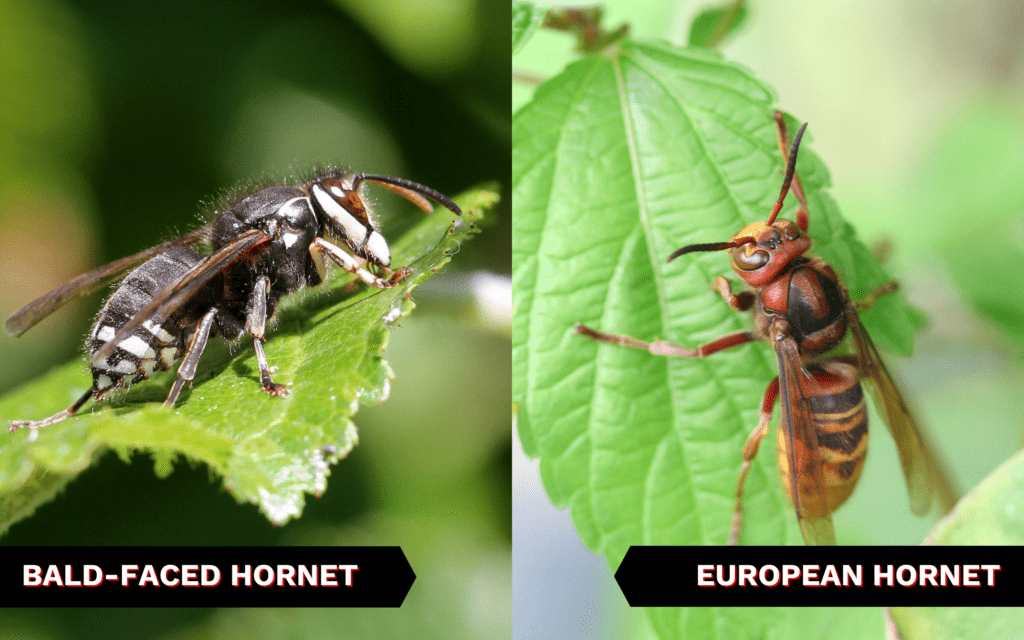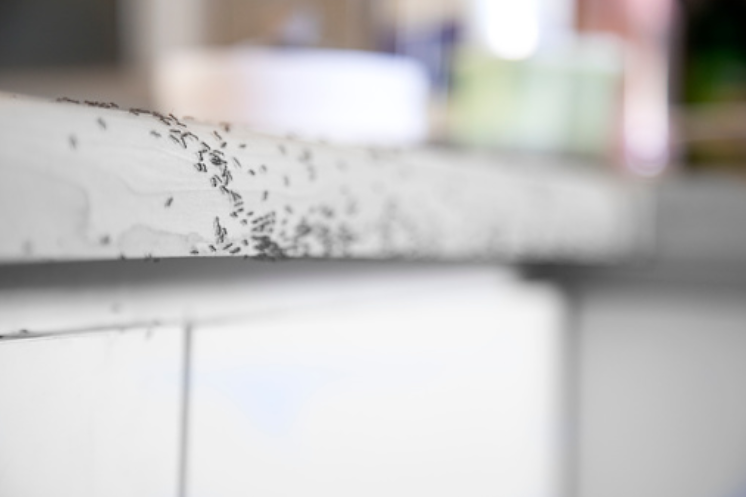Summer months in the Midwest are picturesque. The weather’s hot, the sun is shining, the plants are lush, the flowers are blooming; everything is bright and green again.
No longer do we dream of the sun and heat, it’s here! Just picture all of your favorite summertime activities, like relaxing outside on the patio sipping your favorite beverage – BUZZ – Planting flowers in the garden bed – BUZZ – Watching the kids run through the sprinkler – BUZZ – Grilling a delicious meal for the family – BUZZ – BUZZ…
With all that fun comes the dreaded stinging insects of summer; the bees, wasps and hornets that force you to abandon your outdoor activities and seek shelter inside. Don’t let these insects ruin your sun-filled adventures. Here’s what you need to know about these pesky pests and how to manage them.
What is the Difference Between Bees, Wasps and Hornets?
They fly, they sting, they are unwanted. But how can you tell the difference between a bee, wasp and hornet?

Most people see a black and yellow flying, buzzing insect and think ‘bee’. You may even use the labels of bee, wasp, and hornet interchangeably. While they are similar, the three are actually very different insects.

There are over 20,000 bee species in the world, and 4,000 of them are native to the United States. Bees are pollinators, which makes them a vital part of our world’s ecosystem. Honey bees alone pollinate 80 percent of all flowering plants, including more than 130 types of fruits and vegetables. Honey bees and Bumblebees are not aggressive, they only sting when threatened, so you should leave them bee.
Appearance
Bees are usually brownish-black with a banded yellow and brown abdomen. They have wide bodies and are very hairy. They have hair all over their body, legs, and even around their eyes. Bee’s hairy bodies allow pollen particles to easily stick to them, making pollination possible.
Bee Stings
Bees sting to defend themselves and their colony. If you get stung by a bee you know that the bee was female; only female bees have stingers. Honey bees have barbed stingers that will remain in the skin when the bee flies away. This is the reason Honey bees can only sting once and will die after stinging. Bumblebees do not have a barbed stinger and therefore can sting multiple times.
To treat a bee sting you should remove the stinger, wash the sting and put an ice pack on the sting to help decrease any swelling. If you are allergic to bee stings you should seek medical treatment immediately after being stung.
Nests

Honey bees build large hives that are made from wax that they produce. The wax is built in a comb structure and acts as storage units for pollen and their young. Bee colonies will construct their hives inside of existing structures or cavities such as hollow trees, logs, attics, or walls if they can find their way in. Bees also build their hives underground. As long as the Honey bees and nest remain healthy the hive will remain active for many years.

There are over 4,000 types of wasp species living in the United States. The most common types of wasps in the U.S. are Yellow Jackets, Paper Wasps, Mud Daubers and Ground Wasps. Wasps are predators. They prey on other insects such as flies, caterpillars, grasshoppers, aphids, and other “bad” bugs that can be harmful to crops and plants. Many gardeners don’t mind wasps because of their predatory abilities as well as their ability to help pollinate, although their role as pollinators is a minor one.
Appearance
Wasps have the body of a predator, not a forager like bees. Their bodies are more streamlined than the thick, wide bee body. Wasps are slim and have narrow waists and legs. They don’t have the hair that honey bees or bumble bees have, so their skin appears shiny. Wasps are smaller than hornets and typically have black and yellow markings.

All hornets are wasps, but not all wasps are hornets. We’ll give you a minute to wrap your head around that. It’s true though, hornets are a type of wasp. In fact, they are the largest type of wasp. While they share most of the same traits as wasps and are a part of the wasp family, hornets do get a classification all to themselves.
Appearance

The major difference between wasps and hornets is their size and color. Hornets are larger overall. They have wider heads and larger, more rounded abdomens. The fastest way to tell if you’re dealing with a hornet is by their colors. The two most common types of hornets in the United States are the Bald-Faced hornet and the European hornet. The Bald-Faced hornet will have black and white markings while the European hornet will have an orange head and yellow bottom.
Wasp and Hornet Stings
Wasps and hornets are aggressive insects and will not hesitate to sting you. Unlike bees who die once they sting, wasps and hornets can sting multiple times. When wasps and hornets sting they inject venom into your skin, causing the sting to be more painful than that of a bee sting.

Wasp and Hornet Nests
Wasps and hornets construct their nests from their saliva and chewed wood pulp. The result is a paper-like material. They build their nests in shady areas that are protected from the elements. Most species of wasps and hornets will use their nest for only one year. Ground wasps, like yellow jackets, build their nests underground. You may notice a small, cone-like pile of dirt with a hole in the center of it. If you see wasps or hornets coming in and out you’ve got yourself a ground hive.
What Attracts These Insects and How To Keep Them Away
In the summer months, it’s not uncommon to see the occasional bee or wasp traveling through your yard. The problem starts when they pick your home as their home. Here are some factors that could entice bees, wasps and hornets to congregate around your property and tips on how to keep them from sticking around.
Shelter – Bees and wasps look for safe, well-protected areas to build their hives. Common places around the house or yard they’ll try to set up camp are roof awnings, doorways, inside walls, attics, or around dense foliage. Seal all doors, windows, and small gaps or crevices around your property. Check under the eaves of structures frequently to make sure nests are not being built.
Food – Bees and wasps are constantly on the hunt for new, prosperous food sources. That’s why when you’re at an outside picnic you’ll notice more bees than you would regularly. Your food is a main bee attraction. While you can’t keep 100% of the bees and wasps away from your cookouts you should keep your food covered when it’s not being eaten and make sure to clean up spills or food scraps properly.
Sugar – Who doesn’t like a little something sweet? Sugar sources are a main food source for bees. If you have fruit trees, hummingbird feeders, or leftover food and drink containers from sugary items bees are sure to find them. Make sure your trash is cleaned up properly and that your garbage bins have lids on them to prevent bees from finding their way inside. Any fallen fruit from trees should be picked up and thrown away.
Flowers – Bees, wasps and hornets are all attracted to flowers, which is a good thing because they are all pollinators! But that can mean that the more beautiful flowers you have around your yard the more bees you’ll attract. When planting flowers make sure they are a safe distance from any outside sitting area.
These tips are helpful for avoiding unwanted bees and wasps from your property, but if you’ve taken all precautions and still have a hive or large population of bees, the best tip is to call a professional. Effective and efficient pest control is what Madsen Pest does best! Give us a call at (715) 791-4777. Our expert technicians are productive and thorough, allowing you to get back to enjoying your summer activities!
Related Posts
Rodents in My House? How To Perform Your Own Inspection
This blog will teach you how to inspect your home for rodent activity.
Ants: 3 Ways To Get Them Out of Your Kitchen
To get rid of an ant infestation in your kitchen, identify and seal-off entry points, destroy the nests, and set traps.
3 Ways to Have an Insect-Free Backyard Party
Make sure your backyard party is bug free by eliminating standing water and keeping your lawn tidy and clean.



